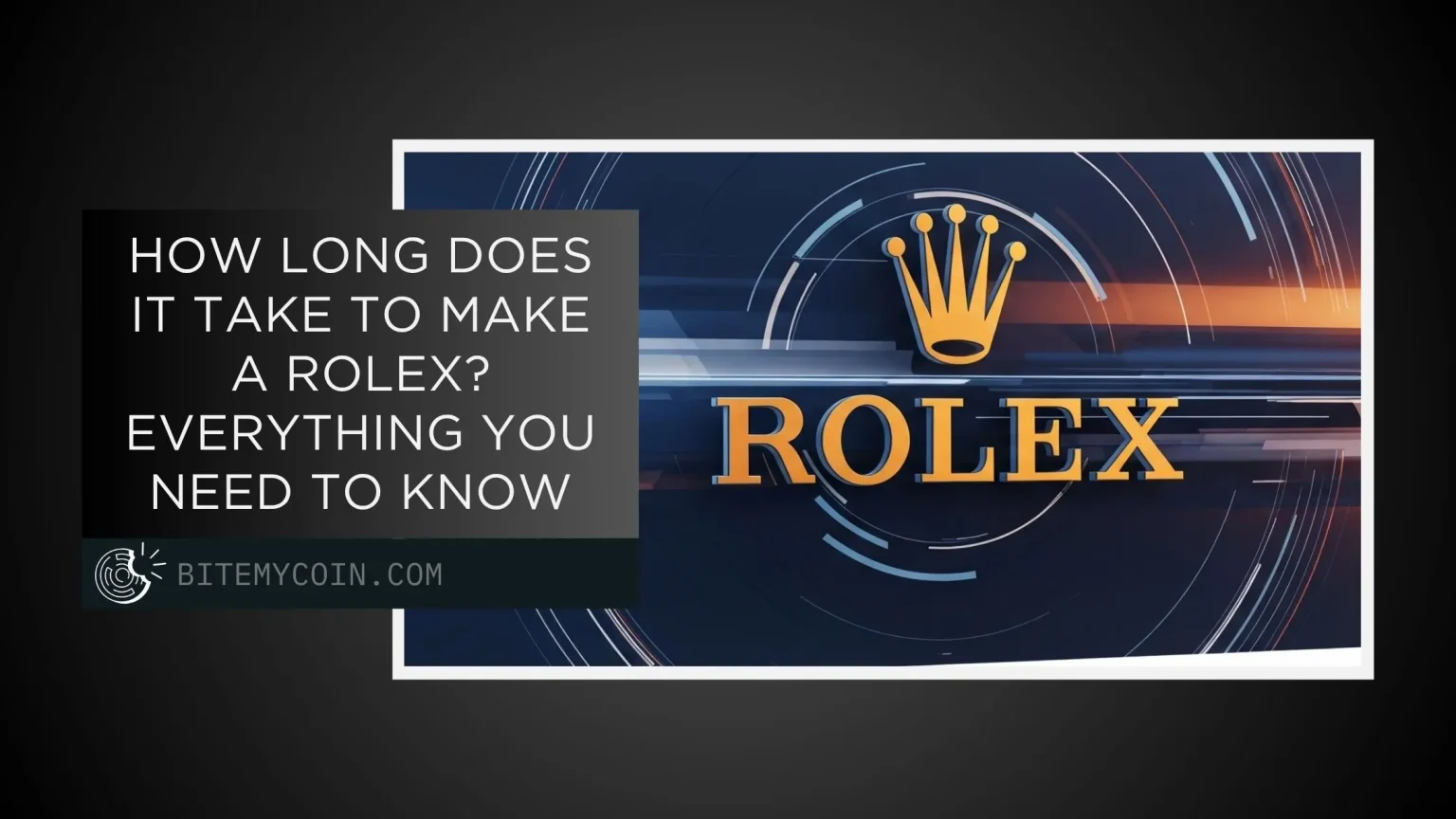Rolex is not just a brand, but a statement in the world of watches. In recent years, skyrocketing demand for its various models has far outweighed supply. The waiting list is so long that many customers were quoted years-long wait times for their timepieces, and some authorized dealers refrain from adding any more names to their allocations.
Some users on Rolex forums suggest that it could take around a year to produce a single Rolex. They claim that this is the case due to the complex processes involved in the watch’s production and the need for the highly exquisite parts to be ready before final assembly. However, with the watches being produced simultaneously, the entire assembly process could take as little as 3-4 hours to complete. According to this estimate, Rolex produces more than 2,000 units per day and more than 1 million watches a year.
This article is a guide covering everything that you need to know about the Rolex manufacturing process, the time it takes for the watches to be produced, how you could get on the prestigious Rolex waiting list, and the average wait times for the most popular models.
Average Waiting Time for Rolex Models In 2025
Here is a table that shows the average time it takes for customers to receive their Rolex models based on the collection:
|
Rolex Collection |
Reported Wait Time |
|---|---|
|
Submariner |
4 Months to 3 Years |
|
Daytona |
2 to 5 Years |
|
Datejust |
3 Months to 2 Years |
|
GMT Master II |
6 Months to 4 Years |
|
Milgaus |
24 Months |
|
Yacht-Master |
24 Months |
|
Explorer |
6 Months to 1 Year |
|
Oyster Perpetual |
6 Months to 1 Year |
Processes Involved In Making a Rolex
The process of manufacturing a Rolex is complex and meticulous, and involves numerous stages, from the creation of raw materials to the final testing of the finished product. The Swiss luxury brand is known for producing all components of the watch in-house, except for the sapphire crystals and watch hands, which adds to the time required to deliver a single timepiece.
Rolex forges its own metals, makes its own lume, and produces its own grade of sapphire glass, which is produced in batches and stored as a work in progress (WIP). While the final assembly may not take long, the entire process of making more than 200 parts from scratch would take months. Quality control checks can also impact the manufacturing time.
Let’s take a closer look at the year-long production process and the materials involved:
1. Manufacturing Sites
Every individual part of a Rolex – from the case, to the strap, to the mechanical movement – is manufactured on-site at one of four locations within Switzerland, and each facility is designated for a specific purpose.
Bienne
The Bienne facility is the only one based outside of Geneva, and is where Rolex produces its watch movements. Each movement is meticulously manufactured by a skilled team by hand, who often work with extremely small components. The assembly is carried out with such precision that all components made at the facility meet the Swiss Official Chronometer Testing Institute’s (COSC) accuracy criteria.
Plan-les-Ouates
This facility is Rolex’s foundry, where it produces watch cases and bracelets. Activities at Plan-les-Ouates include the creation of 18-carat gold alloys used on the watches, their subsequent casting, and the polishing of the final parts before they are ready for assembly.
Chene-Bourg
The Chene-Bourg facility is where Rolex conducts all gem-based activities, from gemmology to setting the gems on the watch face. Additionally, the company also manufactures its watch dials here.
Acacias
Acacias serves as the company’s headquarters, housing its communications, design, sales, and R&D teams. Here, Rolex tests everything from the lubricants used on the machinery to stressing the watches themselves. They simulate wear and tear conditions to ensure that each timepiece’s cases and internal components are robust and fit for the occasion.
2. Materials
Rolex would not be a Rolex without its exquisite craftsmanship. When it comes to selecting the material for each part of every timepiece, the brand adheres to its own philosophy and is fully dedicated to creating the single most perfect product that is inspiring and truly feels like something special.
904L Stainless Steel
While most watchmakers use 316L and 314L-grade stainless steel, Rolex exclusively uses a special blend of the alloy that is more resistant to rust and corrosion. The 904L stainless steel, officially known as Oystersteel, is much stronger and harder than other grades, helping it withstand intense and repeated polishing.
904L is commonly used in aerospace and chemical industries due to its anti-corrosion properties, and is harder to work with, which is why most manufacturers opt for the standard 316L variety instead. Rolex receives its steel from a small number of suppliers, but all the work on it is done in-house, using top-of-the-range machinery.
Gold
The Plan-Les-Ouates facility is where Rolex produces its 18-carat gold alloys, which comprise 750% pure gold and other elements, including copper and silver. Rolex controls the entire manufacturing process to ensure durability and the ability to polish it to their specifications. They produce three types of 18ct gold alloys: yellow, white, and Everose – the highly exclusive pink gold alloy, which is turned into casings and other components of the watch.
Rolesor
Rolesor is a Rolex-patented casing that combines gold and silver on one timepiece. On yellow and Everose gold models, the bezel, winding crown, and the center links of the bracelet are cast in gold, and the casing and outer bracelet links are in 904L steel. Rolesor models in white gold only feature the 18ct gold on the bezel, while the rest of the watch is cast in stainless steel.
Cerachrom
Rolex introduced a new type of shiny bezel called Cerachrom, promising more durability for models like the Submariner and GMT-Master II. This material is scratch-resistant and fade-proof, remaining unaffected by exposure to direct sunlight and chlorinated or salt water. The bezels are initially carved into ceramic and later coated with a layer of gold or platinum using a Physical Vapor Deposition (PVD) process done in a vacuum chamber. It takes 40 hours to make a single cerachrom bezel.
Mother of Pearl
Mother-of-pearl refers to the iridescent inner layer of certain mollusk shells, which is used as dial material in Rolex watches. This natural material is known for its captivating play of colors, which can range from pinks and whites to greens and blues, and unique texture depending on the part of the shell from which it is taken. Each mother-of-pearl dial is unique, meaning that not two watches using the material are ever alike. Rolex does not add artificial colors to the material.
3. Research and Testing
Rolex’s research and testing process is a comprehensive and rigorous endeavor to ensure the precision, durability, and reliability of its watches. The company employs 6,000 people in the department, with many of them being scientists and researchers in other fields.
All R&D activities are conducted at its headquarters in Acacias, where the design, research, and development teams work on creating new watch models and improving existing ones. Throughout its history, Rolex has developed a strong reputation for innovation in the field of watch-making. The company owns more than 400 patents, and its list of innovations includes creating the first-ever waterproof wristwatch (Oyster), the first watch to resist water at a depth of 100 meters (Submariner), and the first watch to display two different time zones simultaneously (GMT-Master).
Whenever a new technology or material is developed, Rolex puts it through rigorous testing to ensure it meets their highest standards. The company measures the watch’s ability to withstand exposure to water, extreme temperatures, shocks, and vibrations with the Superlative Chronometer test. They are also submerged in water at multiple depths for extended periods to measure their resistance.
The process also involves testing individual components such as the machine movement, bracelet, and case. Watchmakers and engineers at Rolex carefully inspect each component to ensure that it meets the company’s standards, and only components that pass the test are used in production. The final test involves measuring the watch’s performance in real-world conditions. Rolex also subjects its watches to time accuracy, wind efficiency, and power reserve tests.
Wait Times for Popular Rolex Models In 2025

In this section, we have shared the estimated wait times for the most popular Rolex models. These days, there are only a handful of models that are out of reach for non-VIP clients at authorized dealers. Keep in mind that this projection is based on available data and should be considered only an estimation.
1. Rolex Submariner
| Submariner Model | Expected Wait Time |
|---|---|
| Stainless Steel – Black Bezel | 3 Months to 2 Years |
| Stainless Steel – Starbucks, Hulk, Bluesy | 6 Months to 3 Years |
| Two-Tone – Rolesor | 2 Months to 1 Year |
| Solid Gold | Up to 10 Months |
2. Rolex Datejust
| Datejust Model | Expected Wait Time |
|---|---|
| Stainless Steel 41 mm – Fluted Bezel | 2 Months to 3 Years |
| Stainless Steel 41 mm – Smooth Bezel | 2 Months to 2 Years |
| Stainless Steel 36 mm – Fluted Bezel | 2 Months to 1 Year |
| Stainless Steel 36 mm – Smooth Bezel | Up to 10 Months |
| Two-Tone Ladies 31 mm | Up to 10 Months |
3. Rolex Daytona
| Daytona Model | Expected Wait Time |
|---|---|
| Stainless Steel – Panda | 2 to 8 Years (VIP Only) |
| Stainless Steel – Black Dial | 1 to 5 Years (VIP Only) |
| Two-Tone – Rolesor | 6 Months to 2 Years |
| Solid Gold | 6 Months to 2 Years |
| Le Mans | 3 Years+ (VIP Only) |
4. Rolex GMT-Master II
| GMT-Master II Model | Expected Wait Time |
|---|---|
| Pepsi | 3 to 5 Years (VIP Only) |
| GRNR – Steel | 2 to 5 Years |
| Batman | 1 to 4 Years |
| Root Beer | 6 Months to 3 Years |
| GRNR – Rolesor | 6 Months to 3 Years |
| Solid Gold | Up to 10 Months |
5. Rolex Oyster Perpetual
| Oyster Perpetual Model | Expected Wait Time |
|---|---|
| Turquoise Dial – 36 mm | 2 to 5 Years (VIP Only) |
| Candy Pink Dial – 36 mm | 2 to 5 Years |
| Celebration Dial – 36 mm | 1 to 5 Years (VIP Only) |
| Celebration Dial – 41 mm | 3 to 5 Years (VIP Only) |
| Green Dial – 36 and 41 mm | 2 Months to 3 Years |
| Silver / Black Dial – 36 and 41 mm | 2 Months to 3 Years |
6. Rolex Explorer
| Explorer Model | Expected Wait Time |
|---|---|
| Explorer 36 mm | 1 Month to 1 Year |
| Explorer 40 mm | 2 Months to 2 Years |
| Explorer II | 5 Months to 3 Years |
7. Rolex Sky-Dweller
| Sky-Dweller Model | Expected Wait Time |
|---|---|
| Mint Green Dial | 2 to 5 Years (VIP Only) |
| Blue Dial | 2 to 5 Years (VIP Only) |
| White / Black Dial | 1 to 5 Years |
| Rose Gold with Blue / Green Dial | 2 to 5 Years (VIP Only) |
| Gold / Rolesor | 2 Months to 2 Years |
What Is the Rolex Waiting List?
The Rolex waitlist is the process by which potential customers can request to be notified when a specific Rolex model is available at an authorized dealer closest to them. Unlike other waiting lists, this is not on a first-come-first-serve basis, but rather an “interest list” managed at the store level. Rolex, on its own, does not maintain a waiting list; therefore, the availability of its watches can vary significantly depending on the model, customer demand, and region.
The waitlist can be short for models with less demand, but highly sought-after models require wait times of several years. Additionally, the market premium above MSRP for the coveted models can be high, with some watches selling for over 200% above their original price. Certain models are exclusively reserved for VIP and VVIP customers.
Rolex’s waitlist is more like a wishlist, where dealers prioritize customers based on various categories, such as their relevance, relationship with the dealer, and spending history.
How to Get on the Rolex Waitlist In 2025?
The process to get into a Rolex waitlist typically involves visiting an authorized dealer and expressing interest in a specific model, though there is no guarantee of when or if the watch you wish to purchase will become available. Rolex does not have a customer inventory, so the list is handled at the store level.
Here are some key steps that you need to consider to gain entry to a Rolex waitlist:
- Visit the authorized Rolex dealer closest to you, and establish a relationship with them. Rolex encourages its dealers to prioritize local customers.
- Grow your relationship with the dealer by visiting the store regularly and showing genuine interest in Rolex models. Maintaining a healthy relationship with the dealer can increase your chances of being considered for a watch.
- Demonstrate genuine interest in the brand and learn its history.
- Familiarize yourself with the Rolex models and be flexible about your preferences. This can reduce your waiting times as less popular models have shorter waitlists.
- Since Rolex’s waitlist is based on the customer’s relevance, patience is key. The dealer will notify you when a watch becomes available.





